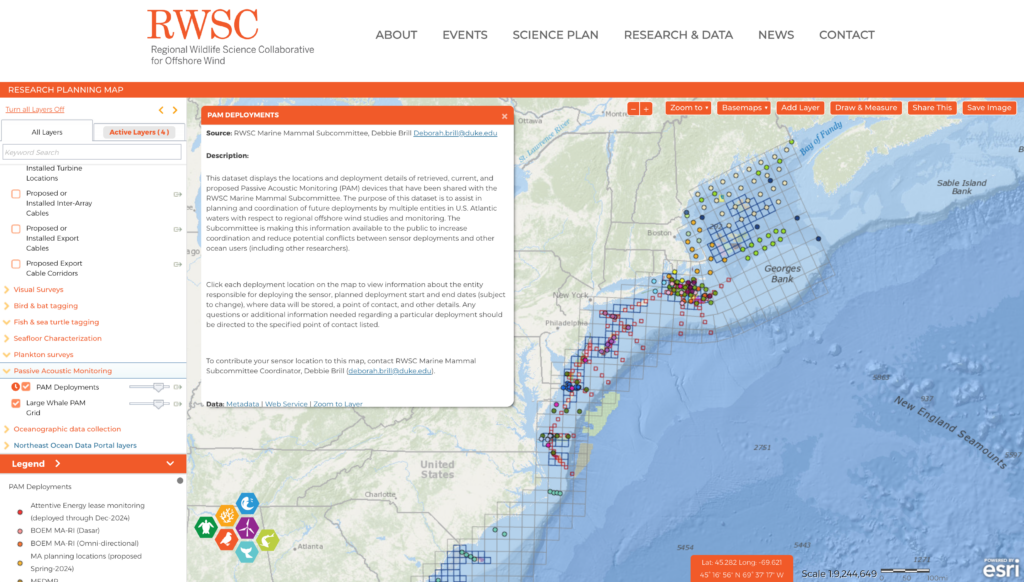RWSC convenes all four Sectors (federal agencies, states, offshore wind companies, eNGOs) on regional deployment, data management, and analysis of long-term/archival PAM. The RWSC Marine Mammal Subcommittee leads this work. Read the RWSC Marine Mammal Subcommittee Passive Acoustic Monitoring Workshop Summary (September 2023) for a complete synopsis of this topic.
The research community and state, federal, and industry funders of long-term/archival passive acoustic monitoring (PAM) in U.S. Atlantic waters have the common goal of detecting and characterizing any broad-scale shifts in baleen whale detections as offshore wind projects are constructed and operate throughout the region.
RWSC is providing the forum for coordination. RWSC hosted a PAM Workshop in September 2023 to continue and expand on activities of the Marine Mammal Subcommittee ongoing since early 2022. RWSC has also held PAM coordination meetings for individual subregions (Southern New England in June 2023 and NY/NJ Bight in May and September 2024). Participants in these activities provide RWSC with coordinates of planned and deployed PAM sensors for sharing on a regional map (see DEPLOYMENT MAPS tab). A coast-wide grid is used to help guide deployments and maximize coverage.
To share your PAM deployments with RWSC and the Subcommittee, download the template and return it to Debbie Brill, RWSC Marine Mammal Subcommittee Coordinator.
Offshore wind companies: Long-term/archival PAM are required within the project footprint as part of each approved offshore wind project. The number of sensors and duration of required monitoring is different for each project. Vineyard Wind 1 and South Fork Wind coordinated the development of their PAM Plans with RWSC. Some companies are also voluntarily deploying PAM in and near their lease area, and developing partnerships with states, universities, and/or research institutions to manage the work.
States: Several states are funding long-term archival PAM deployment. The ASMFC is coordinating among the states from Maine through Maryland on the use of $30M from a federal appropriation to advance North Atlantic right whale research and monitoring. These funds are part of a multi-year appropriation over the next six years. Several states have expressed interest in using a portion of these funds to support PAM deployment. The proportion of the total fund that each state receives is tied to the number of lobster permit-holders in each state.
Project WOW: The Project WOW team has partnered with Vineyard Wind 1 and Empire Wind to deploy long-term/archival PAM within each lease area as part of their DOE-BOEM-funded project.
RWSC News tagged with “PAM”
The RWSC Marine Mammal Subcommittee has developed and maintains map layers showing the components of a proposed Passive Acoustic Monitoring (PAM) design for regional long-term monitoring near Atlantic offshore lease areas and wind energy areas in the RWSC Research Planning Map. Click on the map to learn more about locations where PAM devices are currently located.
To add your data to this map, download and fill out the PAM deployment locations metadata template OR if you have already submitted instrument metadata via NOAA Fisheries Passive Acoustic Reporting System templates, send/forward to Debbie Brill, Marine Mammal Subcommittee Coordinator.

PAM Data Management Best Practices (RWSC Marine Mammal Subcommittee)